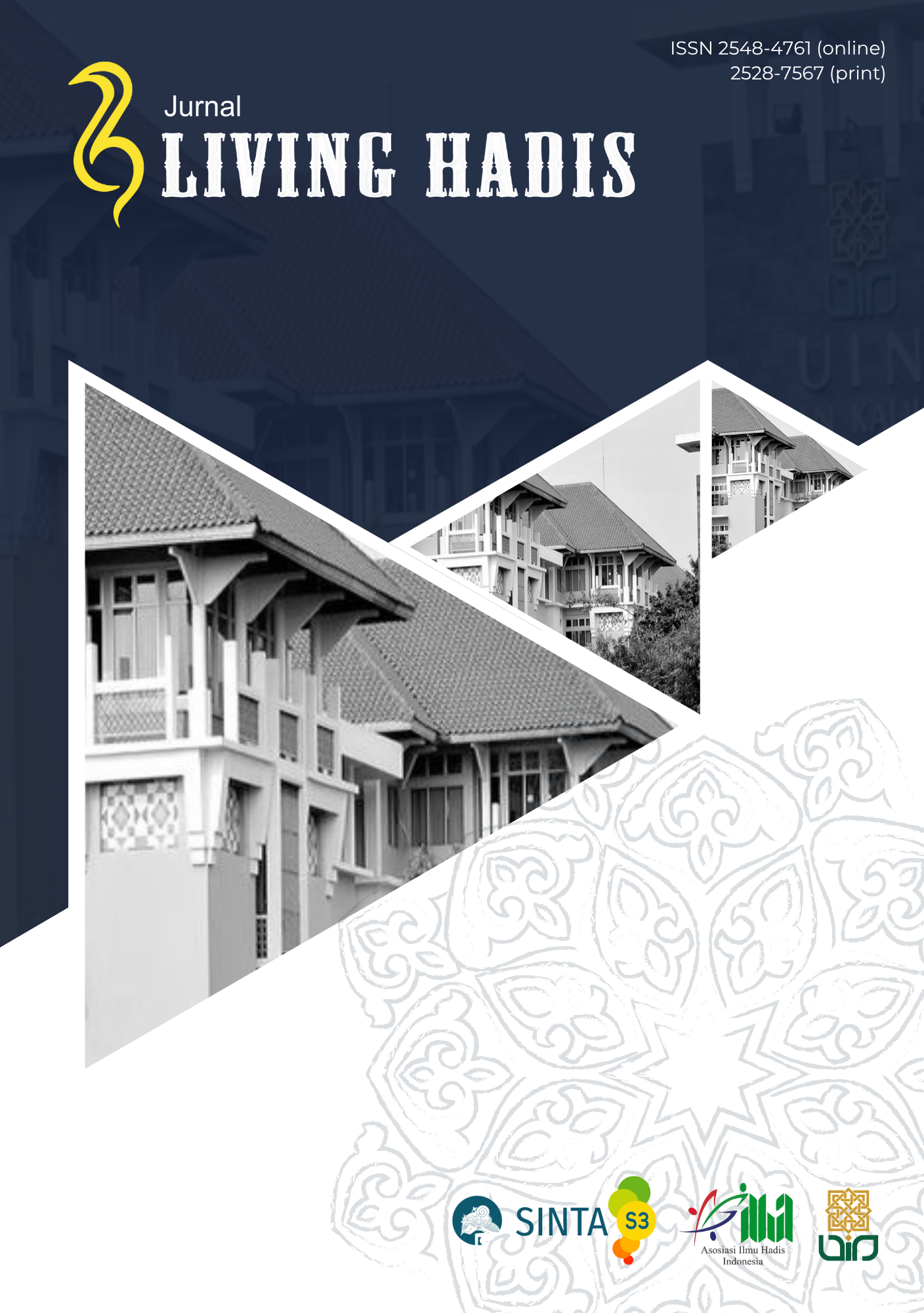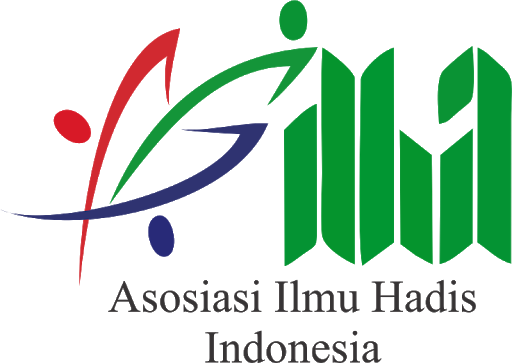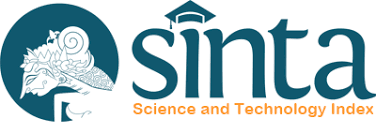The Transformation of Understanding Hadith in the Post-Multimedia Era: Balancing Technological Advancements with Tradition Preservation
Transformasi Pemahaman Hadis di Era Pasca-Multimedia: Menyeimbangkan Kemajuan Teknologi dengan Pelestarian Hadis
DOI:
https://doi.org/10.14421/livinghadis.2024.5798Keywords:
Transformation, Understanding Hadith, Post-Multimedia Era, Digital Technology, Preservation of TraditionAbstract
Technological advances in the post-multimedia era have brought about significant changes in various aspects of life, including in the understanding and dissemination of hadith. Multimedia technology provides faster and wider access to hadith literature, allowing Muslims to access authentic sources more easily. Nevertheless, this transformation also poses challenges in maintaining the authenticity and preservation of the tradition of hadith understanding that has developed over the centuries. This research aims to explore how the development of multimedia technology affects the transformation of people's understanding of hadith and how it interacts with efforts to maintain the interpretive traditions inherited by classical scholars. Using a qualitative method with an interpretive-hermeneutic approach was adopted to help interpret the shifting understanding of hadith among the younger generation and religious communities. The results show that although technological advances have enriched access to hadith, there are concerns about misinterpretation due to the lack of control of authoritative scholars. However, technology also provides opportunities for Islamic scholars and educational institutions to adapt, utilizing multimedia as a means of da'wah as well as the preservation of tradition. Therefore, synergistic efforts between technological innovation and strengthening Islamic literacy are needed so that the understanding of hadith in the post-multimedia era remains authentic and relevant.
 Abstract viewed: 537 times
|
Abstract viewed: 537 times
|
 pdf downloaded = 530 times
pdf downloaded = 530 times
References
Abdelaal, H. M., & Youness, H. A. (2019). Hadith Classification using Machine Learning Techniques According to its Reliability. Romanian Journal of Information Science and Technology, 22(3–4), 259–271.
Adryansyah, M. R. H., Quiroz, P. A., Zuhdi, M. I., & Sutabri, T. (2023). Perancangan Multimedia Teknologi Virtual Reality Dan Augmented Reality Sebagai Media Pameran Digital. Technologia : Jurnal Ilmiah, 14(3), 214–220. https://doi.org/10.31602/tji.v14i3.11518
Afwadzi, B. (2015). Melacak Argumentasi Penggunaan Semiotika dalam Memahami Hadis Nabi. Jurnal Studi Ilmu-Ilmu Al-Qur’an Dan Hadis, 16(2), 287–319. https://doi.org/10.14421/qh.2015.1602-08
Al-Bukhārī, A. ‘Abdillāh M. bin I. (1993). Ṣaḥīḥ al-Bukhārī (M. D. Al-Bugā, Ed.). Damaskus: Dār Ibnu Kaṡīr.
Al-Dārimī, A. M. ‘Abdillah bin ‘Abdurrahman bin al-F. bin B. bin ‘Abd al-Ṣamad. (2000). Musnad al-Dārimī (Ḥusain Sulaim Asad Al-Dārānī, Ed.). Saudi Arabiyyah: Dār al-Mugnī.
Al-Naisābūrī, A. al-Ḥusain M. bin al-Ḥajjāj al-Q. (1955). Ṣaḥīḥ Muslim (M. F. ‘Abd Al-Bāqī, Ed.). Kairo: Muṣṭafā al-Bābī al-Ḥalabī.
Al-Nasā’ī, A. ‘Abdirraḥmān A. bin S. (2018). Sunan al-Nasā’ī (M. R. ‘Arqaswaī, Ed.). Beirūt: Dār al-Risālah al-‘Ilmiyyah.
Al-Sijistānī, A. D. S. bin al-A. bin I. bin B. bin S. bin ‘Amr al-A. (1993). Sunan Abū Dāwud (M. M. ‘Abd Al-Ḥamīd, Ed.). Beirūt: al-Maktabah al-Iṣriyah.
Al-Tirmiżī, M. bin ‘Īsā bin S. bin M. bin al-Ḍaḥḥāk A. ‘Īsa. (1975). Sunan al-Tirmiżī (A. M. Syākir & M. F. ‘Abd Al-Bāqī, Eds.). Mesir: Muṣṭafā al-Bābī al-Ḥalabī.
Amir, S. M., Harahap, A. P., Rahmi, T., & Nazmi, K. (2024). Transformative Islamic Education Based on Hadith Values: Leadership Character Building Strategy for Santri. Al-Fikru: Jurnal Ilmiah, 18(2), 159–172. https://doi.org/10.51672/alfikru.v18i2.497
Anas, M. bin. (1985). al-Muwaṭṭā’. Beirūt: Dār Iḥyā’ al-Turāṡ al-‘Arābī.
Annaba, A. F., & Soleh, K. (2022). Edukasi Digital: Pembelajaran Ilmu Agama Islam Melalui Kanal Youtube Dalam Pandangan Tradisi Ilmu Sanad. Islamic Journal of Education, 1(1), 73–85. https://doi.org/10.54801/ijed.v1i2.132
Anwa, K., Awang, M. S., & Sahid, M. M. (2021). Maqasid Syariah According To Imam Al-Ghazali and Its Application in the Compilation of Islamic Law in Indonesia. Malaysian Journal of Syariah and Law, 9(2), 75–87. https://doi.org/10.33102/mjsl.vol9no2.315
Azmi, A. M., Al-Qabbany, A. O., & Hussain, A. (2019). Computational and natural language processing based studies of hadith literature: a survey. Artificial Intelligence Review, 52(2), 1369–1414. https://doi.org/10.1007/s10462-019-09692-w
Bahrudin, M. K., Suliaman, I., & Mohamed Adnan, M. A. (2023). The Reality and Challenges of Authoritative Regulation on Hadith Publication in Malaysia and Indonesia. Jurnal Usuluddin, 51(1), 81–114. https://doi.org/10.22452/usuluddin.vol51no4
Bimbo, C. C. (2019). Islam Today in Modern West: Fazlur Rahman’s and Tariq Ramadan’s Views on Jihad. Ulumuna, 23(1), 71–89. https://doi.org/10.20414/ujis.v23i1.289
Chande, A. (2023). Global Politics of Knowledge Production: The Challenges of Islamization of Knowledge in The Light of Tradition Vs Secular Modernity Debate. Nazhruna: Jurnal Pendidikan Islam, 6(2), 271–289. https://doi.org/10.31538/nzh.v6i2.3502
Chunlin, L., Yanpei, L., Youlong, L., & Min, Z. (2017). Collaborative content dissemination based on game theory in multimedia cloud. Knowledge-Based Systems, 124, 1–15. https://doi.org/10.1016/j.knosys.2017.02.026
Daffa, M. (2022). Analysis Of Hadith Understanding Of Social Media Phenomena As A Communication Tool In The Digital Era. Riwayah : Jurnal Studi Hadis, 8(1), 69–86. https://doi.org/10.21043/riwayah.v8i1.11209
Daud, Z., & Junus, R. A. (2023). The Use of Maktabah Syamilah Software in Increasing Students’ Interest of Learning Hadith: A Survey. Journal Of Hadith Studies, 8(2), 94–104. https://doi.org/10.33102/johs.v8i2.249
Doll Kawaid, A. I. S., Syed Hassan, S. N., Aris, H., Mohd Ghazali, N., Marhusin, M. F., Azman, N., … Mohamed Nor, Z. (2023). Pembinaan Pangkalan Data Hadis Lengkap Dalam Bahasa Melayu Untuk Data Raya (Big Data): Kajian Kes Terhadap Cabaran Yang Dihadapi Oleh Kumpulan I-Status Hadis. Journal Of Hadith Studies, 8(2), 82–93. https://doi.org/10.33102/johs.v8i2.248
Fadilha, R. (2020). Resepsi Hadis di Media Sosial Studi Kasus Film Animasi Nussa Episode Adab Menguap. ISLAMICA: Jurnal Studi Keislaman, 14(2), 27–42. https://doi.org/10.35719/amn.v8i1.21
Farooqi, A. M., Malick, R. A. S., Shaikh, M. S., & Akhunzada, A. (2024). Multi-IsnadSet MIS for Sahih Muslim Hadith with chain of narrators, based on multiple ISNAD. Data in Brief, 54, 110439. https://doi.org/10.1016/j.dib.2024.110439
Febriani, I. S., Rumsiti, A. S., Maulana, K., & Hermawan, R. (2024). Living Al-Quran Dan Hadits Di Era Digital: Pemanfaatan Belajar Tafsir Online Untuk Generasi Milenial. Geneologi PAI: Jurnal Pendidikan Agama Islam, 11(1), 53–64. https://doi.org/10.32678/geneologipai.v11i1.9948
Gravina, R., Alinia, P., Ghasemzadeh, H., & Fortino, G. (2017). Multi-sensor fusion in body sensor networks: State-of-the-art and research challenges. Information Fusion, 35, 68–80. https://doi.org/10.1016/j.inffus.2016.09.005
Hadi, R. T. (2020). Studi Aplikasi Hadis Era Mobile. Islam Transformatif : Journal of Islamic Studies, 4(1), 13–24. https://doi.org/10.30983/it.v4i1.2629
Hafidhuddin, H. (2021). Kontestasi Hadis di Era Multimedia: Kajian Hadis di Youtube Mengenai Alat Musik. Al-Bayan: Jurnal Ilmu Al-Qur’an Dan Hadist, 5(1), 30–42. https://doi.org/10.35132/albayan.v5i1.182
Hammedi, S., Essalmi, F., Jemni, M., & Qaffas, A. A. (2020). An investigation of AI in games: educational intelligent games vs non-educational games. 2020 International Multi-Conference on: “Organization of Knowledge and Advanced Technologies” (OCTA), 1–4. https://doi.org/10.1109/OCTA49274.2020.9151738
Ḥanbal, A.-I. A. bin. (1995). Musnad al-Imām Aḥmad bin Ḥanbal. Kairo: Dār al-Ḥadīṡ.
Harahap, A. P. (2023). Partisipasi Politik Perempuan: Analisis Hadis Terhadap Peran Perempuan Dalam Sistem Demokrasi Indonesia. Moderate El Siyasi: Jurnal Pemikiran Politik Islam, 2(2), 1–15. https://doi.org/10.30821/moderateel-siyas.v2i2.23294
Harahap, A. P., & Wahyuni, A. M. (2024). Peran Perempuan Sebagai Mufassir dan Kontribusinya Terhadap Pendidikan Islam. Ibn Abbas: Jurnal Ilmu Alquran Dan Tafsir, 7(1), 1–21. https://doi.org/10.51900/ias.v7i1.22548
Hasanah, U. (2023). Historical Approach in Understanding Hadith. UMRAN - International Journal of Islamic and Civilizational Studies, 10(2), 37–51. https://doi.org/10.11113/umran2023.10n2.598
Istianah, I. (2020). Era Disrupsi Dan Pengaruhnya Terhadap Perkembangan Hadis Di Media Sosial. Riwayah : Jurnal Studi Hadis, Vol. 6, pp. 89–102. https://doi.org/10.21043/riwayah.v6i1.6861
Istianah, & Wahyuningsih, S. (2019). The Hadith Digitization in Millennial Era: A Study at Center for Hadith Studies, Indonesia. QIJIS (Qudus International Journal of Islamic Studies), 7(1), 25–44. https://doi.org/10.21043/QIJIS.V7I1.4900
Istiqlal, M. (2017). Pengembangan Multimedia Interaktif Dalam Pembelajaran Matematika. JIPMat, 2(1), 43–54. https://doi.org/10.26877/jipmat.v2i1.1480
Kamaluddin, A. (2023). Naqd As-Sanad : Metodologi Validasi Hadits Shahih. Mushaf Journal: Jurnal Ilmu Al Quran Dan Hadis, 3(2), 229–239. Retrieved from https://mushafjournal.com/index.php/mj/article/view/136
Kamla, R., & Alsoufi, R. (2015). Critical Muslim Intellectuals’ discourse and the issue of ‘Interest’ (ribā): Implications for Islamic accounting and banking. Accounting Forum, 39(2), 140–154. https://doi.org/10.1016/j.accfor.2015.02.002
Karim, A. (2019). Pergulatan Hadis di Era Modern. Riwayah : Jurnal Studi Hadis, 3(2), 171–184. https://doi.org/10.21043/riwayah.v3i2.3720
Keil, J., Edler, D., & Dickmann, F. (2019). Preparing the HoloLens for user Studies: an Augmented Reality Interface for the Spatial Adjustment of Holographic Objects in 3D Indoor Environments. KN - Journal of Cartography and Geographic Information, 69(3), 205–215. https://doi.org/10.1007/s42489-019-00025-z
Mājah, A. ‘Abdillāh M. bin Y. I. (2014). Sunan Ibnu Mājah (M. F. ‘Abd Al-Bāqī, Ed.). al-Su’ūd: Dār al-Ṣadīq.
Malek, Y. N., Kharbouch, A., Khoukhi, H. El, Bakhouya, M., Florio, V. De, Ouadghiri, D. El, … Blondia, C. (2017). On the use of IoT and Big Data Technologies for Real-time Monitoring and Data Processing. Procedia Computer Science, 113, 429–434. https://doi.org/10.1016/j.procs.2017.08.281
Miski. (2020). Nalar Hermeneutis Ulama Hadis: Larangan Perempuan Bepergian tanpa Mahram dalam Ruang Sejarah Pemahaman. DINIKA : Academic Journal of Islamic Studies, 2(1), 71–96. https://doi.org/10.46388/ijass.2020.13.1
Mufid, A., Massoweang, A. K., Mujizatullah, M., Muslim, A., & Yani, Z. (2023). Rereading Nasr Hamid Abu Zayd’s method of interpreting religious texts. HTS Teologiese Studies / Theological Studies, 79(1), 1–6. https://doi.org/10.4102/hts.v79i1.8102
Muhtador, M. (2019). Dinamika Memahami Hadis Nabi: Tinjauan Historis dan Metodologis. Riwayah : Jurnal Studi Hadis, 3(2), 185–196. https://doi.org/10.21043/riwayah.v3i2.3704
Nancy Um. (2020). Yemeni Manuscripts Online: Digitization in an Age of War and Loss. Manuscript Studies: A Journal of the Schoenberg Institute For, 5(1), 1–44. https://doi.org/10.1353/mns.2020.0006
Nawir, M. (2022). Inclusive and Exclusive Understanding of the Doomsday Prediction Hadith: Pemahaman Inklusif dan Ekslusif Terhadap Hadis Prediksi Hari Kiamat. Takwil: Journal of Quran and Hadith Studies, 1(2), 51–68. https://doi.org/10.32939/twl.v1i2.1690
Nirwana, D. (2015). Diskursus Studi Hadis Dalam Wacana Islam Kontemporer. Al-Banjari : Jurnal Ilmiah Ilmu-Ilmu Keislaman, 13(2), 178–203. https://doi.org/10.18592/al-banjari.v13i2.397
Nižetić, S., Djilali, N., Papadopoulos, A., & Rodrigues, J. J. P. C. (2019). Smart technologies for promotion of energy efficiency, utilization of sustainable resources and waste management. Journal of Cleaner Production, 231, 565–591. https://doi.org/https://doi.org/10.1016/j.jclepro.2019.04.397
Noetel, M., Griffith, S., Delaney, O., Harris, N. R., Sanders, T., Parker, P., … Lonsdale, C. (2021). Multimedia Design for Learning: An Overview of Reviews With Meta-Meta-Analysis. Review of Educational Research, 92(3), 413–454. https://doi.org/10.3102/00346543211052329
Nurdin, A. (2020). Designing Powtoon-Mediated Interactive Multimedia to Leverage Students’ Learning Behavior in the Qur’an and Hadith. Edukasia Islamika, 5(2), 158–174. https://doi.org/10.28918/jei.v5i2.1067
Nurjaman, A. I., & Hamdu, G. (2018). Pengembangan Multimedia Interaktif Pelaksanaan Pembelajaran Outdoor Permainan Tradisional Berbasis STEM di SD. Pedadidaktika, 5(3), 85–99. https://doi.org/10.17509/pedadidaktika.v5i3.12728
Qomarullah, M. (2022). Metode Kritik Matan Hadis Dengan Pendekatan Alquran Dalam Kaidah Ilmu Naqd Al-Matan. AL QUDS : Jurnal Studi Alquran Dan Hadis, 6(3), 1427–1450. https://doi.org/10.29240/alquds.v6i3.4041
Rahmanda, R. Y., Pramukantoro, E. S., & Yahya, W. (2018). Perancangan dan implementasi kelas virtual Filkom universitas brawijaya dengan memanfaatkan teknologi webRTC (Web real-time communication). Jurnal Pengembangan Teknologi Informasi Dan Ilmu Komputer, 2(7), 2721–2729. Retrieved from http://j-ptiik.ub.ac.id
Ramzy, A., Torki, M., Abdeen, M., Saif, O., ElNainay, M., Alshanqiti, A. A., & Nabil, E. (2023). Hadiths Classification Using a Novel Author-Based Hadith Classification Dataset (ABCD). Big Data and Cognitive Computing, 7(3), 141. https://doi.org/10.3390/bdcc7030141
Rosyad, S., & Alif, M. (2023). Hadis di Era Digital: Tantangan dan Peluang Penggunaan Teknologi dalam Studi Hadis. Jurnal Ilmu Agama: Mengkaji Doktrin, Pemikiran, Dan Fenomena Agama, 24(2), 185–197. https://doi.org/10.19109/jia.v24i2.18979
Saad, M. (2023). Reviving the Narrative of Muhammad’s Life: Tariq Ramadan’s Interpretative Strategies and Ethical Contextualization. Mutawatir : Jurnal Keilmuan Tafsir Hadith, 13(1), 1–25. https://doi.org/10.15642/mutawatir.2023.13.1.1-25
Sefriyono, Ilhamni, & Rahmi. (2022). Hadis-Hadis Jihad: dari Humanisme Menuju Kekerasan Agama. Mashdar: Jurnal Studi Al-Qur’an Dan Hadis, 4(2), 191–204. https://doi.org/10.15548/mashdar.v4i2.4662
Siregar, I., & Harahap, A. P. (2024a). Kontekstualisasi Hadis Tentang Kurangnya Kecerdasan Perempuan dan Agama. Tajdid: Jurnal Ilmu Ushuluddin, 23(1), 218–257. https://doi.org/10.30631/tjd.v23i1.442
Siregar, I., & Harahap, A. P. (2024b). The Relevance of Hadith and Reason in Demonstrating The Status of Hadith. Al-Bukhari : Jurnal Ilmu Hadis, 7(1), 16–33. https://doi.org/10.32505/al-bukhari.v7i1.8237
Siregar, R. H., & Harahap, A. P. (2024). Keseimbangan Peran Perempuan Sebagai Ibu Dan Pekerja: Tinjauan Komprehensif Dalam Perspektif Al-Quran Dan Hadis. Ibn Abbas: Jurnal Ilmu Alquran Dan Tafsir, 7(2), 133–150. https://doi.org/10.51900/ias.v7i2.22741
Song, W., Liu, L., Tian, Y., Sun, G., Fong, S., & Cho, K. (2017). A 3D localisation method in indoor environments for virtual reality applications. Human-Centric Computing and Information Sciences, 7(1), 39. https://doi.org/10.1186/s13673-017-0120-7
Supriyadi, T., Julia, Aeni, A. N., & Sumarna, E. (2020). Action Research in Hadith Literacy: A Reflection of Hadith Learning in the Digital Age. International Journal of Learning, Teaching and Educational Research, 19(5), 99–124. https://doi.org/10.26803/ijlter.19.5.6
Syarifudin, M., & Masruhan, M. (2021). INTERPRETASI HADIS: ANTARA HERMENEUTIKA DAN SYARH AL-HADITS (STUDI KOMPARATIF). TAJDID: Jurnal Ilmu Ushuluddin, 20(2), 373–400. https://doi.org/10.30631/tjd.v20i2.171
Taghian, M. (2024). Assessing the accuracy criteria of AI tools-aided translation: a case study of two-word Prophetic Hadiths. CDELT Occasional Papers in the Development of English Education, 87(1), 217–262. https://doi.org/10.21608/opde.2024.384369
Taufiq, F., & Alkholid, A. M. (2021). Kontekstualisasi Hadis tentang Jihad dan Relevansinya dalam Konflik Timur Tengah. AL QUDS : Jurnal Studi Alquran Dan Hadis, 5(1), 337–348. https://doi.org/10.29240/alquds.v5i1.2471
Triadi Antara, K. (2024). Pengaruh IoT pada Transformasi Jaringan Multimedia: Literatur Review. Jurnal Ilmu Komputer Dan Sistem Informasi (JIKOMSI), 7(1), 173–181. https://doi.org/10.55338/jikomsi.v7i1.2736
Ummah, S. S. (2019). Digitalisasi Hadis (Studi Hadis di Era Digital). Diroyah: Jurnal Ilmu Hadis, 04(01), 1–10. https://doi.org/10.15575/diroyah.v4i1.6010
Wang, R., Ji, W., Liu, M., Wang, X., Weng, J., Deng, S., … Yuan, C. (2018). Review on mining data from multiple data sources. Pattern Recognition Letters, 109, 120–128. https://doi.org/https://doi.org/10.1016/j.patrec.2018.01.013
Widyastri, S., Nata, A., Al Munawar, S. A. H., & Suparto, S. (2022). Transmission of Al-Qur’an Learning in Saudi Arabia and Indonesia. International Journal of Islamic Thought and Humanities, 1(2), 117–131. https://doi.org/10.54298/ijith.v1i2.37
Yotenka, R., Dini, S. K., Fauzan, A., & Ahdika, A. (2022). Exploring the relationship between hadith narrators in Book of Bukhari through SPADE algorithm. MethodsX, 9, 101850. https://doi.org/10.1016/j.mex.2022.101850
Yusuf, M. F., Siregar, B. B. R. N., & Harahap, A. P. (2024). Implementation of Hadith as a Foundation for Deradicalization in Contemporary Islamic Education Curriculum. At-Turāṡ: Jurnal Studi Keislaman, 11(2), 160–177. https://doi.org/10.33650/at-turas.v11i2.9358
Zhu, W., Wang, X., & Gao, W. (2020). Multimedia Intelligence: When Multimedia Meets Artificial Intelligence. IEEE Transactions on Multimedia, 22(7), 1823–1835. https://doi.org/10.1109/TMM.2020.2969791
Downloads
Published
Issue
Section
License
Copyright (c) 2025 Alwi Padly Harahap, Rahmi Syahriza, Asrar Mabrur Faza

This work is licensed under a Creative Commons Attribution-ShareAlike 4.0 International License.
- Authors who publish with this journal agree to the following terms:
- Authors retain copyright and grant the journal right of first publication with the work simultaneously licensed under a Creative Commons Attribution License that allows others to share the work with an acknowledgement of the work's authorship and initial publication in this journal.
- Authors are able to enter into separate, additional contractual arrangements for the non-exclusive distribution of the journal's published version of the work (e.g., post it to an institutional repository or publish it in a book), with an acknowledgement of its initial publication in this journal.
- Authors are permitted and encouraged to post their work online (e.g., in institutional repositories or on their website) prior to and during the submission process, as it can lead to productive exchanges, as well as earlier and greater citation of published work.

















